Please Note: This post may contain affiliate links. If you click one of them, we may receive a commission at no extra cost to you. As an Amazon Associate, I earn from qualifying purchases.
Top Takeaways and Key Concepts
- Choose a safe campsite by avoiding rivers, low ground, and insect-infested areas.
- Build a simple shelter using branches and leaves to stay warm and dry.
- Master basic fire skills with tinder, kindling, and backup ignition methods like flint.
- Find safe food and water through smart foraging, fishing, filtering, and boiling.
- Use clear rescue signals like reflective flashes, whistles, or SOS markers to get help.
Summary of This Article
This article teaches essential wilderness survival skills in a fun and practical way. It explains how to set up a safe campsite, build a weather-resistant shelter, and start a fire using both basic and improvised tools. Readers also learn how to find food and purify water safely, plus how to signal for help in emergencies. With creativity, preparation, and smart techniques, anyone can boost survival confidence outdoors.
Short Video Version of this Article
Ah, the wonderful outdoors! What a lovely setting. Fresh air, tall trees, and all the beautiful things about nature. But then there’s the time when you’re attempting to put up your tent and you’re knee-deep in mud. Ugh! It can seem like an expedition that went wrong.
Sometimes, camping feels like a means to deal with the discomfort of sleeping on the ground and getting attacked by insects. If you’ve thought that, you’re not the only one. But don’t be afraid! Let’s speak about some interesting techniques that can help you get from “What am I doing?” to “I’ve got this!”
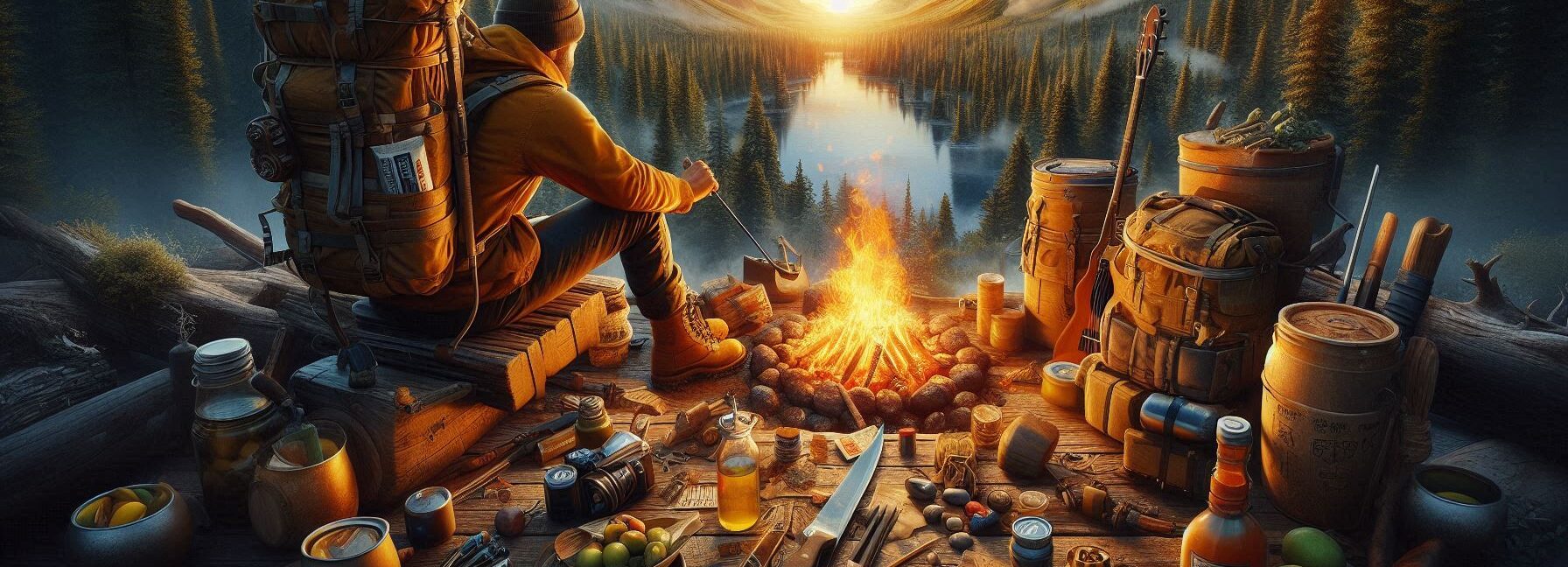
Think about how easy it would be to set up camp. Before you set up your tent, lay down a small tarp. It will keep the muck away and provide you a place to work that is dry. Easy, right?
The bug spray comes next. You have to have it! It can keep those annoying bites away. And it helps if you bring some candles or aromatic scents with you. There are some smells that mosquitoes don’t like.
It can be hard to cook in the outdoors. Bringing a little camping stove is a big deal. It’s far easier than trying to light a fire. And you can get dinner ready quickly.
Prepare for a fun camping vacation! These small pieces of advice will help you feel better. Let’s get our stuff together and make the most of our time outside!
The Art of Building a Shelter: Not Just for Squirrels
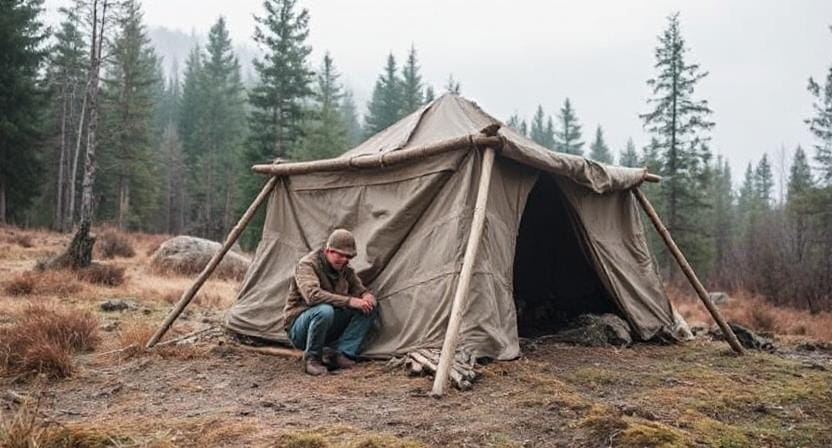
Have you ever tried to build a shelter, by the way? It’s like building with LEGO bricks, but with sticks and leaves and no directions (which is why half of my shelters look like they belong in an abstract art gallery).
Having a good shelter might mean the difference between telling stories over the campfire and shivering under a tarp at night when you’re trying to stay warm in the woods.
Location is the most important thing. You don’t want to set your shop directly next to a river, unless you like waking up with wet socks. Find a higher place where rainwater won’t turn your tent into a swimming pool by accident.
And don’t forget that no one wants to wake up with ants on their face. Oh no! It’s not a good idea to set up your tent too close to an ant hill.
It’s time to get creative now that you’ve found the right area! For a moment, think of yourself as an architect. That’s really cool! A simple lean-to made of branches can keep you safe from the rain and wind.
Just get some strong branches and lean them on a rock or tree. Make a pretty triangle. Then, put leaves or pine needles on top of it. There you go! You made a shelter that would even impress Bear Grylls. Not quite a full-on survival expert, but near enough to keep you dry when it rains unexpectedly.
You might even want to show it off to your buddies. Camping is a lot more fun and comfortable when you have a cozy place to stay. Also, it feels good to make things with your hands. It’s like a mini journey all by itself! Like being outside and making your own area. You can do it!
Fire-Making 101: More Than Just Playing with Matches
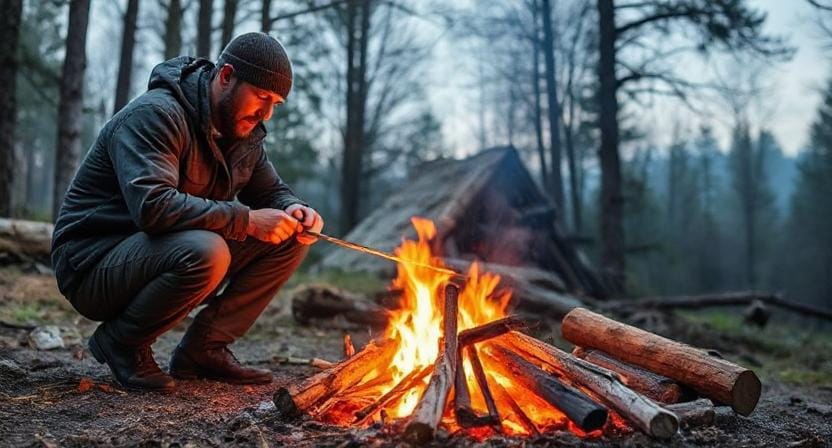
Honestly, if there’s one thing every outdoor enthusiast should know, it’s how to make fire. Sure, we all love roasting marshmallows over an open flame while singing campfire songs (or attempting poorly sung renditions of pop hits), but fire also keeps us warm and wards off pesky critters looking for midnight snacks.
Let’s see…when starting a fire, it helps to gather tinder first—think dry leaves, grass clippings, or those annoying dryer lint balls you find hiding in your laundry room (seriously, what are those doing there?).
Once you’ve collected enough tinder that would make any squirrel proud, create a small pile and add kindling (small sticks) around it like it’s about to become the star of its own reality show.
Lighting a fire is super fun, right? Using waterproof matches or a lighter is the best way to go. But let’s be real here. If you drop them in water while trying to show off your “survival skills,” you might need a Plan B.
That’s where flint and steel come into play. It’s like a little magic trick! If you’ve got those, you can spark a flame pretty easily. If you don’t have that, there’s always the classic method: rubbing two sticks together. Sounds kind of romantic, huh? But, oh boy, it’s hard work!
You’ll be rubbing and rubbing, thinking, “Why did I choose this?” But when you finally get it right, it’s like… Voilà! Instant warmth and light. You feel like a total champ!
And hey, having a fire isn’t just about warmth. It’s great for cooking, too. Imagine roasting marshmallows or warming up some soup. Yum! Just keep an eye on it, and don’t let it get out of control. That would be a big mess.
So whether you’re the match master or the stick rubbers, getting that fire going is totally worth it. Enjoy the cozy vibes and the glow of the flames. You’ve got this! 🔥
Food Procurement: From Foraging to Fishing
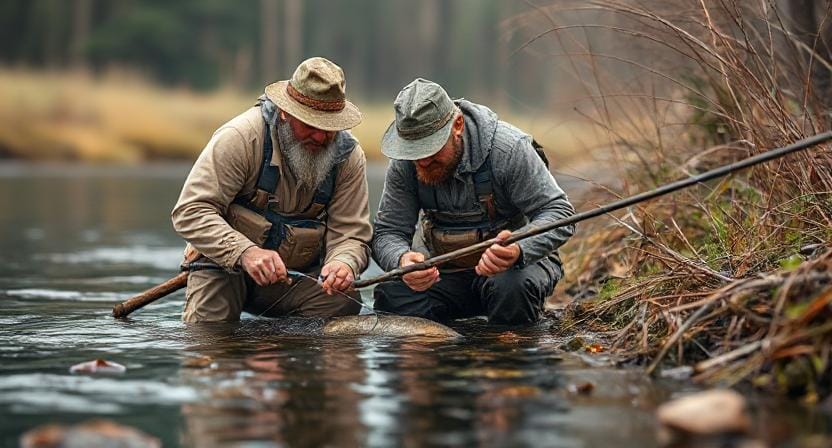
Speaking of food…let’s talk about how not to starve in the wild unless you’re planning on becoming best friends with wild berries—which may or may not be poisonous (thanks for nothing!). First off, learning what edible plants are safe is crucial unless you’d prefer dining on dandelions as part of your gourmet wilderness cuisine.
Foraging isn’t just about munching on random greens; it’s also about finding nuts and fruits that pack energy without requiring elaborate cooking methods (because let’s face it—you probably won’t have access to Gordon Ramsay).
Acorns? Yep, you can eat those. Just gotta leach out the toxins first. It sounds fancy, but it’s really not that hard. Then there’s wild garlic. Oh man, it smells so good! Toss it in a meal, and it’s like a flavor party!
But hey, if you’re not sure about something, it’s probably best to stick with trail mix. Trail mix is a winner. No guessing there. You can’t go wrong with nuts, dried fruit, and maybe some chocolate. Yum!
Fishing is another fun way to get food. Doesn’t that sound cool? But let me tell you, catching dinner is not as easy as just tossing out a line. You need patience. And some questionable dance moves while you wait for the fish to bite. Trust me, fish love a show!
If you’re up for it, bring along simple fishing gear. Or, you could get crafty like Native Americans did. Learning how to make traps from natural materials around you is pretty neat. Just imagine wearing a little fish triumphantly on your hook. It’s quite a feeling!
So, whether you’re foraging or fishing, there’s adventure in both. Just keep it fun and enjoy whatever you catch! Even if it’s just a good story to tell later. Happy adventuring! 🎣✨
Water Purification Hacks: Because Drinking Pond Water Isn’t Cool

An interesting fact: most people don’t like it when you drink water straight from a pond because it can make your stomach do acrobatics that make you wish you hadn’t done it. How do we acquire clean water without having to buy bottled spring water?
Oh, let’s talk about water! You know that staying hydrated is important, right? Using cotton filters is a great trick. Cut up some old clothes you don’t wear anymore, like that blouse you never wear. You can help clear this cloth by pouring dirty water through its layers. Not perfect, but better than nothing, right? Keep pouring until it looks clean enough to consume.
Another fantastic choice is to boil water. Put it over the fire and wait for the bubbles to start dancing. You know it’s done when they start to bubble like crazy. If it steams, it’s okay to drink. Who would have thought that boiling water could be such fun?
And now I’ll tell you about sun stills. This one is cool! It makes fresh water by using sunlight and some digging. You dig a small hole and put some plants in it. Then, put plastic over it. The plastic gets wet when the sun warms everything up. You get fresh water underneath it as it cools down. It’s like a magic trick from nature!
There are fun ways to find drinkable water, like filtering, boiling, or digging in the sun. It’s all about being innovative and using what you have to the fullest. Drink lots of water, my friend!💧✨
Signaling for Help: How Not to Be Invisible
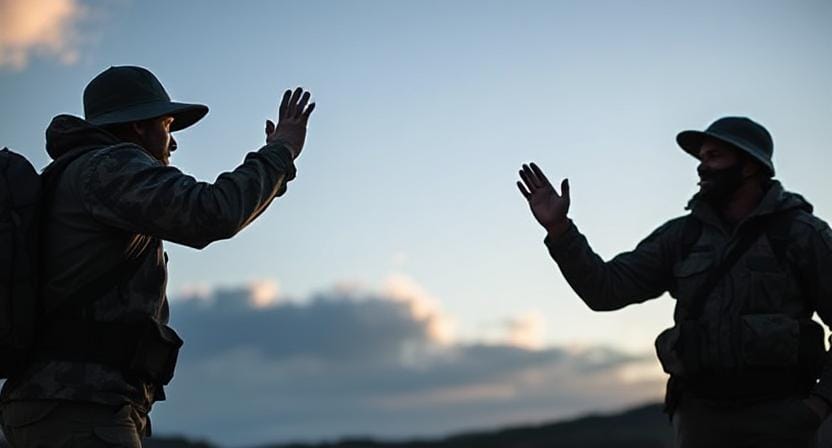
Let’s say things went awry during your adventure—you tripped over roots like they were ninja assassins sent specifically after you—and now you’re lost somewhere deep in the woods wondering if anyone knows where you are besides squirrels giggling nearby. Here’s where signaling comes into play!
Okay, let’s chat about getting attention when you’re in trouble. You know those shiny things like mirrors? They can be super helpful! If you have any metal objects, use them. Just point them at the sun and reflect that light around. It catches people’s eyes.
And don’t underestimate noise! Whistle loudly every few minutes. Seriously, make some noise like you mean it. Shout “HELP!” too! You might feel silly, but your voice can go a long way. It’s not just for when family arguments happen at home, you know?
If waiting a bit doesn’t bring help, you could try something else. Gather some rocks and arrange them on flat ground. You can make big symbols like SOS. It’s a way to say, “Hey, I’m here! Please don’t leave me behind!” Just think of it like sending a giant message in the wild.
Being creative and making noise can really help you stay safe. So don’t hold back! Be loud, be bright, and get rescued! You’ve got this! ✨🪨🚨
Final Thoughts: Embrace Your Inner Survivor
Packing food is just one part of getting ready for your next trip. You also need to be smart. Getting ready is important. It’s like preparing a list of things to do before school. You don’t want to forget your lunch, do you?
It’s a big assistance to have the correct gear. A water bottle, good shoes, and maybe a map. You know, just the basics. But let’s be honest. Things don’t always go as planned.
That’s where survival tips come in! They are like cheat codes for life. Stay cool if you get stuck. Tell a joke! If you laugh, you can convert a bad day into a funny narrative later. It makes things feel less heavy.
So, the next time you go out, use all that information and those smart thoughts to show the world what you’re made of! Please, this time, stay away from the quicksand. No one wants to have a problem with dirty shoes, do they? You can do it!
Learning wilderness survival skills helps you stay safe, calm, and prepared when unexpected challenges arise outdoors. By mastering shelter building, fire making, food sourcing, water purification, and rescue signaling, you gain the confidence to handle emergencies and enjoy nature more responsibly and independently.
Frequently Asked Questions
What is the most important step when choosing a campsite?
The most important step is to pick a safe, dry location away from rivers, low terrain, and insect-heavy areas to avoid floods, pests, and hazards.
How can I build a simple survival shelter?
You can build a basic lean-to by leaning branches against a tree or rock and covering them with leaves or pine needles for insulation.
What are the easiest ways to start a fire in the wild?
Use dry tinder and small sticks with waterproof matches, a lighter, or a flint and steel as a dependable backup method.
How do I find safe food in the wilderness?
Learn to identify non-toxic wild plants, nuts, and berries, and use simple fishing gear or traps for protein sources.
How can I purify water if I don’t have a filter?
You can boil water over a fire for safety, or strain it with cloth before boiling to remove debris and reduce contaminants.
What is the best way to signal for help outdoors?
Use bright signals like reflective flashes, loud whistles, or large SOS symbols made from rocks or branches to attract rescuers.
Why are survival skills important for campers and hikers?
Survival skills help prevent panic, increase safety, and improve decision-making when plans change or emergencies occur outdoors.
Suggested Resources:
Survival Skills Every Outdoor Enthusiast Should Know
https://www.outdoorlife.com/survival-skills-every-outdoor-enthusiast-should-know/
How To Start a Fire Without Matches
https://www.survivopedia.com/start-fire-without-matches/
Edible Plants Guide
https://www.wildfoodadventures.com/edible-plants-guide/

Kevin Collier is a seasoned outdoor enthusiast and writer for Trekbug.com, specializing in outdoor adventures, survival strategies, and prepping insights. With a deep love for nature and a commitment to self-sufficiency, Kevin empowers readers to embrace the wilderness confidently. He shares valuable tips, practical techniques, and inspiring stories, helping both novice and experienced adventurers develop essential skills for surviving and thriving in the great outdoors.





